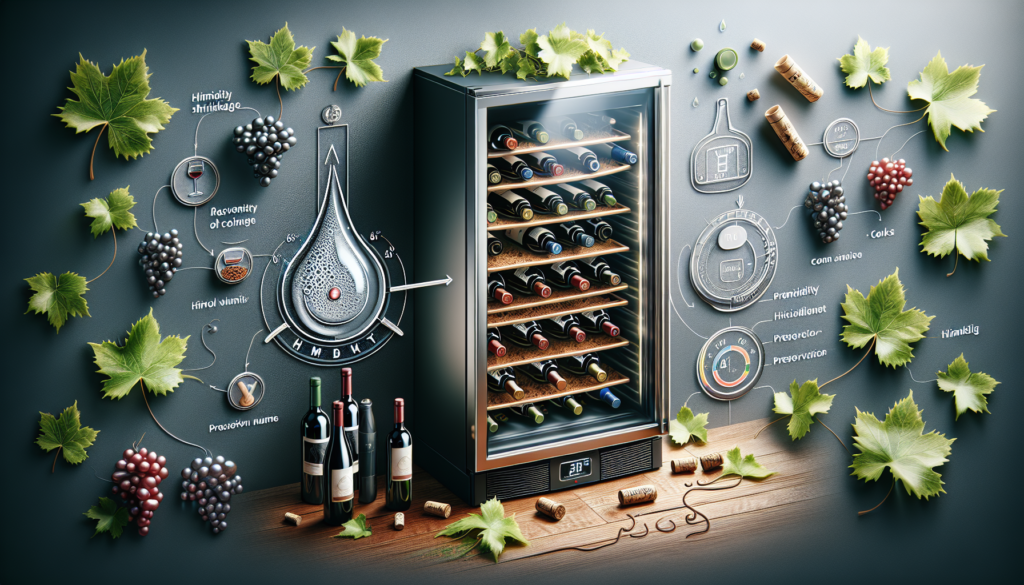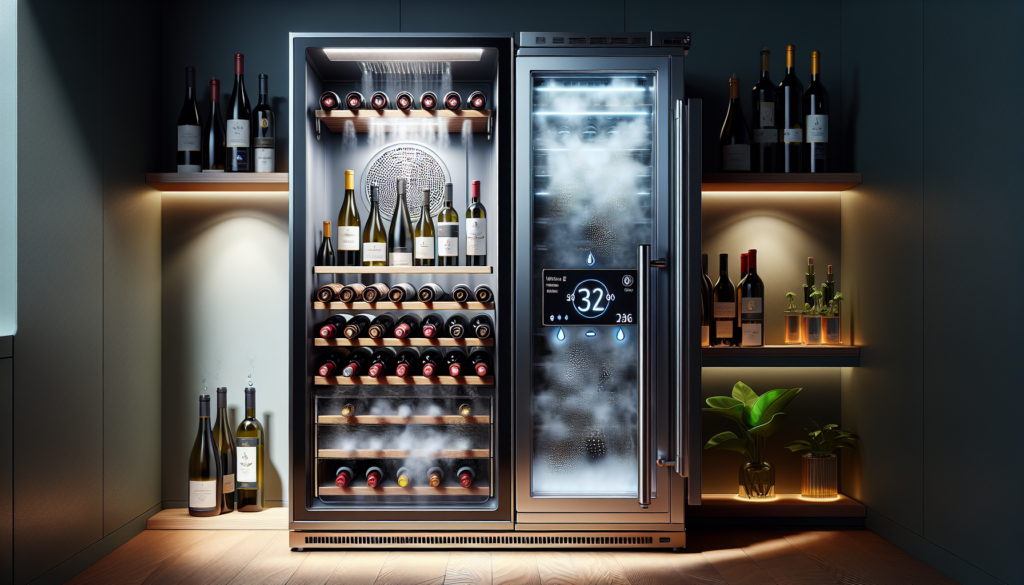Are you a wine connoisseur who takes great pride in curating the perfect collection? If so, then ensuring your wine is stored in optimal conditions is crucial. One often overlooked aspect is the humidity control in your wine fridge. Maintaining the right humidity levels is essential for preserving the integrity and flavor of your precious bottles. In this article, we’ll explore the importance of wine fridge humidity control and provide tips on how to achieve the ideal environment for your favorite vintages. So sit back, pour yourself a glass, and let’s uncork the secrets to preserving your wines in style.

Factors Affecting Wine Fridge Humidity Control
Temperature
Temperature plays a significant role in controlling the humidity levels in a wine fridge. As the temperature rises, the air’s ability to hold moisture increases, leading to lower relative humidity. On the other hand, lowering the temperature can cause an increase in relative humidity. It is crucial to maintain a consistent temperature within the wine fridge to ensure optimal humidity levels.
Air Circulation
Proper air circulation is essential for maintaining humidity control in a wine fridge. Without sufficient air movement, moisture tends to accumulate and create pockets of high humidity, leading to potential mold growth and condensation issues. Ensuring adequate air circulation by arranging wine bottles with space between them and avoiding overcrowding is vital for humidity control.
Sealing
The sealing of a wine fridge is crucial for maintaining humidity control. If the fridge is not adequately sealed, outside air can enter, affecting the internal humidity levels. Any gaps or cracks in the fridge’s door or structure should be repaired to prevent air exchange and maintain a stable environment for your wine collection.
External Environment
The external environment can have a significant impact on the humidity levels inside a wine fridge. Factors such as the overall humidity of your location and the placement of the fridge can influence the fridge’s internal humidity. Keeping the fridge away from areas with excessive humidity, such as kitchens or laundry rooms, can help maintain optimal humidity levels.
Size of the Fridge
The size of your wine fridge can also affect humidity control. Larger wine fridges tend to have better humidity control compared to smaller ones. This is because larger fridges have more room for air circulation and can hold a more significant number of bottles, preventing overcrowding and allowing for better temperature and humidity regulation.
Ideal Humidity Levels for Wine Storage
Why Humidity Level is Important for Wine Storage
The humidity level in a wine fridge is essential for proper wine storage because it directly impacts the wine’s flavor, aroma, and overall quality. Wine bottles have a natural cork closure, and if the humidity is too low, the cork can dry out, leading to unwanted oxygen exposure and potentially spoiling the wine. On the other hand, if the humidity is too high, it can promote the growth of mold and mildew, compromising the wine’s integrity. Maintaining the ideal humidity level is crucial to ensure the longevity and quality of your wine collection.
Optimal Humidity Range for Wine Storage
The ideal humidity range for wine storage typically falls between 50% and 70%. Within this range, the cork remains properly hydrated, preventing oxygen exposure, while also avoiding excessive moisture that could lead to mold growth. It is important to note that different wine experts may recommend slightly varying humidity levels within this range. However, staying within 50% to 70% provides a safe and effective range for most wines.
Methods for Controlling Humidity in a Wine Fridge
Use of Humidifiers
Humidifiers are commonly used to increase humidity levels in a wine fridge. These devices release moisture into the air, helping to maintain the desired humidity range. There are various types of humidifiers available, such as evaporative humidifiers and ultrasonic humidifiers, which utilize different mechanisms to disperse moisture. When using a humidifier, it is essential to monitor humidity levels regularly and adjust the humidifier settings as needed to maintain the optimal range.
Use of Desiccants
Desiccants, such as silica gel packs, are useful in reducing humidity levels in a wine fridge. These moisture-absorbing packets can be placed strategically inside the fridge to remove excess moisture from the air. It is important to choose desiccants specifically designed for food storage to ensure they are safe for use with wine. Regularly checking and replacing the desiccants will ensure their effectiveness in controlling humidity levels.
Sealing Techniques
Proper sealing techniques can also assist in controlling humidity levels in a wine fridge. Adding weatherstripping or gaskets around the fridge’s door can help create a tighter seal to prevent air exchange. Additionally, checking for any gaps or cracks in the fridge’s structure and addressing them promptly will aid in maintaining a stable and controlled environment inside the fridge.
Benefits of Proper Humidity Control in Wine Fridges
Preservation of Wine Quality
Maintaining proper humidity levels in a wine fridge is crucial for preserving the quality of your wine collection. By controlling the humidity, you can ensure that the corks remain properly hydrated, preventing premature oxidation and preserving the wine’s flavors, aromas, and overall characteristics. Consistently high-quality storage conditions can lead to an enhanced tasting experience when you finally uncork your favorite bottle.
Prevention of Spoilage
Controlling humidity in a wine fridge helps prevent the spoilage of wine. Excessive humidity can lead to the growth of mold and mildew on the corks and labels, potentially contaminating the wine. By maintaining the optimal humidity range, you can minimize the risk of spoilage, ensuring that your wine remains in pristine condition.
Maintenance of Cork Integrity
The integrity of the cork is essential for preserving the quality of wine. When the humidity levels are too low, corks can dry out and shrink, leading to air leakage and oxygen exposure. This can significantly impact the wine’s taste and aroma. Proper humidity control ensures that the corks remain in good condition, maintaining an airtight seal and allowing the wine to age gracefully.

Common Problems and Solutions for Wine Fridge Humidity Control
Excessive Humidity
If you encounter excessive humidity in your wine fridge, which can lead to mold growth or moisture-related issues, there are several solutions to consider. Firstly, ensure that the fridge is properly sealed to prevent outside air from entering. You can also try using a dehumidifier to reduce the excess moisture. If these measures do not sufficiently address the problem, it may be necessary to relocate the wine fridge to a less humid area.
Insufficient Humidity
When facing insufficient humidity in your wine fridge, increasing the humidity can be achieved through various methods. Using a humidifier specifically designed for wine fridges is a common solution. Implementing desiccants strategically inside the fridge can also help stabilize the humidity levels. Remember to regularly monitor the humidity to ensure it remains within the optimal range.
Condensation
Condensation can occur in a wine fridge when there is a significant difference between the ambient temperature and the temperature inside the fridge. To reduce condensation, ensure that the fridge’s door is properly sealed. If condensation persists, adjusting the temperature may help alleviate the issue. Regularly cleaning and drying the interior of the fridge will also minimize the chances of condensation forming.
Tips for Maintaining Optimal Humidity Levels in a Wine Fridge
Regularly Monitor Humidity Levels
To ensure optimal humidity levels in your wine fridge, it is important to regularly monitor the humidity. High-quality wine fridges often come equipped with built-in hygrometers or humidity control features, allowing for easy monitoring and adjustment. If your wine fridge does not have these features, consider investing in a separate hygrometer to track the humidity accurately.
Properly Position Wine Bottles
Properly positioning the wine bottles inside the fridge can aid in maintaining optimal humidity levels. Avoid overcrowding the fridge, as this can impede air circulation and create pockets of higher humidity. Leave a small gap between bottles to allow for proper airflow. Additionally, store the bottles horizontally to keep the corks moist and prevent them from drying out.
Avoid Frequent Door Opening
Frequent opening of the wine fridge door can cause fluctuations in temperature and humidity levels. To maintain a stable environment, minimize the number of times you open the door unnecessarily. When accessing your wine collection, try to retrieve the desired bottle quickly and close the door promptly. This will help maintain consistent humidity levels and preserve the overall quality of your wines.
Conclusion
Proper humidity control is crucial for maintaining the quality and longevity of your wine collection. Factors such as temperature, air circulation, sealing, external environment, and the size of the fridge all play significant roles in achieving optimal humidity levels. By understanding the importance of humidity in wine storage and employing appropriate methods and techniques, you can ensure that your wines age gracefully and provide an exceptional tasting experience. Regular monitoring, proper bottle positioning, and minimizing door openings are simple yet effective practices in maintaining the ideal humidity range. With these principles in mind, you can confidently store your wines in a well-controlled environment and enjoy their complexities for years to come.
